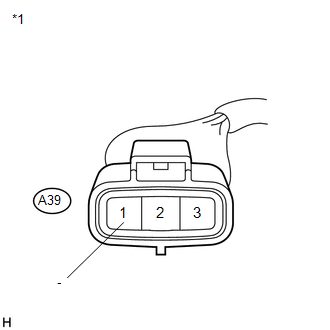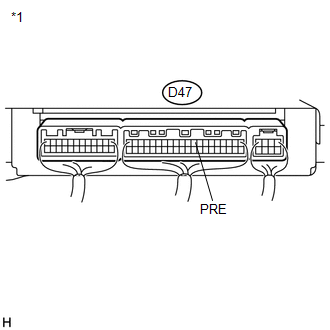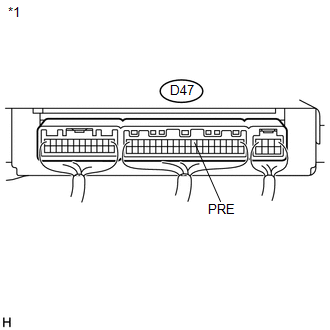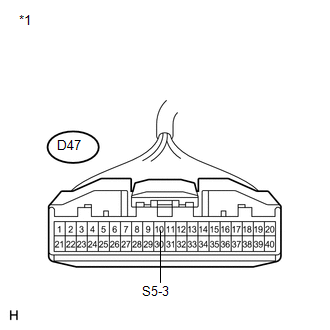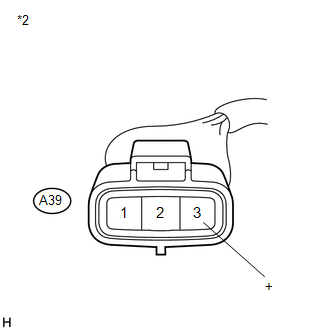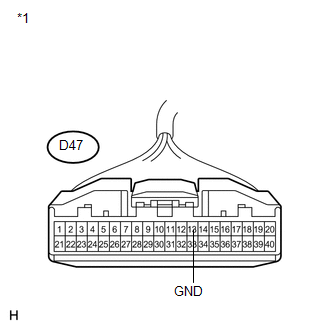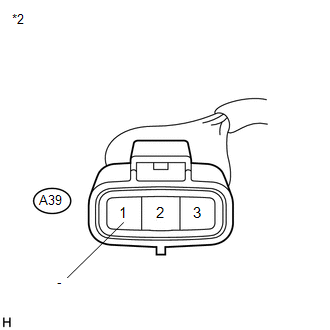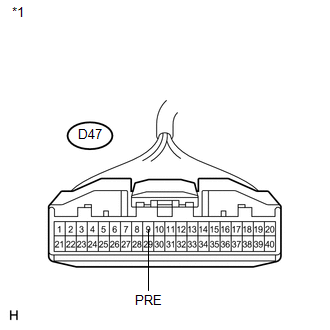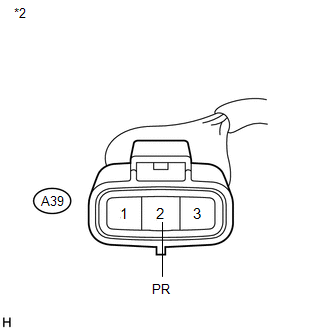Toyota Venza: Pressure Sensor Circuit (B1423/23)
DESCRIPTION
This DTC is output when refrigerant pressure on the high pressure side is extremely low (190 kPa (1.9 kgf/cm2, 28 psi) or less) or extremely high (3140 kPa (32.0 kgf/cm2, 455 psi) or more). The A/C pressure sensor is installed on the high pressure line. It detects refrigerant pressure to output a refrigerant pressure signal to the A/C amplifier. The A/C amplifier converts this signal to a pressure value according to the sensor characteristics to control the compressor.
|
DTC No. |
DTC Detection Condition |
Trouble Area |
|---|---|---|
|
B1423/23 |
|
|
WIRING DIAGRAM
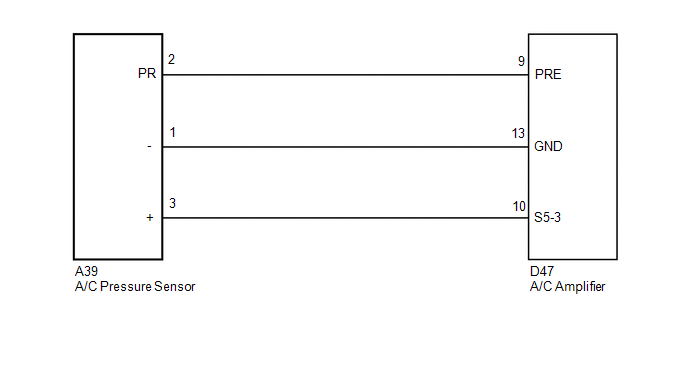
PROCEDURE
|
1. |
CHECK HARNESS AND CONNECTOR (POWER SOURCE CIRCUIT) |
|
(a) Disconnect the A/C pressure sensor connector. |
|
(b) Measure the voltage according to the value(s) in the table below.
Standard Voltage:
|
Tester Connection |
Switch Condition |
Specified Condition |
|---|---|---|
|
A39-3 (+) - Body ground |
Ignition switch ON |
4.75 to 5.25 V |
|
*1 |
Front view of wire harness connector (to A/C Pressure Sensor) |
| NG | .gif) |
GO TO STEP 5 |
|
|
2. |
CHECK HARNESS AND CONNECTOR (GROUND CIRCUIT) |
|
(a) Measure the resistance according to the value(s) in the table below. Standard Resistance:
|
|
| NG | .gif) |
GO TO STEP 6 |
|
|
3. |
INSPECT A/C PRESSURE SENSOR (SENSOR SIGNAL CIRCUIT) |
(a) Reconnect the A/C pressure sensor connector.
|
(b) Remove the A/C amplifier with the connectors still connected. |
|
(c) Measure the voltage according to the value(s) in the table below.
Standard Voltage:
|
Tester Connection |
Condition |
Specified Condition |
|---|---|---|
|
D47-9 (PRE) - Body ground |
Ignition switch ON (A/C: off) |
0.73 to 4.84 V |
HINT:
If the voltage is not as specified, there may be a malfunction in the A/C amplifier, A/C pressure sensor or wire harness. It is also possible that the amount of refrigerant may not be appropriate.
Text in Illustration|
*1 |
Component with harness connected (A/C Amplifier) |
| NG | .gif) |
GO TO STEP 7 |
|
|
4. |
INSPECT A/C PRESSURE SENSOR (SENSOR SIGNAL CIRCUIT) |
(a) Measure the voltage when the following conditions are satisfied.
|
Item |
Condition |
|---|---|
|
Vehicle Doors |
Fully open |
|
Temperature Setting |
MAX COLD |
|
Blower Speed |
HI |
|
A/C Switch |
on |
|
R/F Switch |
RECIRCULATION |
|
Interior Temperature |
25 to 35°C (77 to 95°F) |
|
Engine Speed |
2000 rpm |
NOTICE:
- If refrigerant pressure on the high pressure line becomes extremely high during the inspection (if the voltage exceeds 4.84 V), the fail-safe function stops compressor operation. Therefore, measure the voltage before the fail-safe function operates.
- It is necessary to measure the voltage over a period of time (approximately 10 minutes) because the problem symptom may recur after a while.
HINT:
When the outside air temperature is low (below -1.5°C (29.3°F)), the compressor stops due to signals from the ambient temperature sensor and the evaporator temperature sensor to prevent the evaporator from freezing. In this case, perform the inspection in a warm indoor environment.
|
(1) Measure the voltage according to the value(s) in the table below. Standard Voltage:
Result:
|
|
| A | .gif) |
REPLACE A/C AMPLIFIER |
| B | .gif) |
PROCEED TO NEXT SUSPECTED AREA SHOWN IN PROBLEM SYMPTOMS TABLE |
| C | .gif) |
GO TO STEP 13 |
|
5. |
CHECK HARNESS AND CONNECTOR (A/C AMPLIFIER - A/C PRESSURE SENSOR) |
|
(a) Disconnect the A/C amplifier connector. |
|
|
(b) Measure the resistance according to the value(s) in the table below. Standard Resistance:
|
|
| OK | .gif) |
REPLACE A/C AMPLIFIER |
| NG | .gif) |
REPAIR OR REPLACE HARNESS OR CONNECTOR |
|
6. |
CHECK HARNESS AND CONNECTOR (A/C AMPLIFIER - A/C PRESSURE SENSOR) |
|
(a) Disconnect the A/C amplifier connector. |
|
|
(b) Measure the resistance according to the value(s) in the table below. Standard Resistance:
|
|
| OK | .gif) |
REPLACE A/C AMPLIFIER |
| NG | .gif) |
REPAIR OR REPLACE HARNESS OR CONNECTOR |
|
7. |
CHECK HARNESS AND CONNECTOR (A/C AMPLIFIER - A/C PRESSURE SENSOR) |
|
(a) Disconnect the A/C amplifier connector. |
|
|
(b) Measure the resistance according to the value(s) in the table below. Standard Resistance:
|
|
| NG | .gif) |
REPAIR OR REPLACE HARNESS OR CONNECTOR |
|
|
8. |
CHECK FOR A/C SYSTEM LEAK |
(a) Install the manifold gauge set.
(b) Recover the refrigerant from the A/C system using a refrigerant recovery unit.
(c) Evacuate the A/C system and check that vacuum can be maintained.
OK:
Vacuum can be maintained in the A/C system.
HINT:
If vacuum cannot be maintained in the A/C system, there may be a refrigerant leak. In this case, it is necessary to repair or replace the leaking part of the A/C system.
| NG | .gif) |
GO TO STEP 12 |
|
|
9. |
CHARGE REFRIGERANT |
(a) Add an appropriate amount of refrigerant (See page
.gif) ).
).
|
|
10. |
RECHECK DTC |
(a) Recheck for the DTC when the following conditions are satisfied.
|
Item |
Condition |
|---|---|
|
Vehicle Doors |
Fully open |
|
Temperature Setting |
MAX COLD |
|
Blower Speed |
HI |
|
A/C Switch |
on |
|
R/F Switch |
RECIRCULATION |
|
Interior Temperature |
25 to 35°C (77 to 95°F) |
|
Engine Speed |
2000 rpm |
NOTICE:
If refrigerant pressure on the high pressure line is excessive, this DTC will be set. Therefore, it is necessary to measure the voltage over a period of time (approximately 10 minutes) because this DTC may be set after the A/C has been operating for a while.
HINT:
When the outside air temperature is low (below -1.5°C (29.3°F)), the compressor stops due to signals from the ambient temperature sensor and the evaporator temperature sensor to prevent the evaporator from freezing. In this case, perform the inspection in a warm indoor environment.
|
Result |
Proceed to |
|---|---|
|
DTC B1423/23 is output |
A |
|
DTC B1423/23 is not output |
B |
NOTICE:
If the DTC was set due to an insufficient or excessive amount of refrigerant, the problem may have been solved after performing the previous step. However, the root cause of insufficient refrigerant may be refrigerant leaks. The root cause of excessive refrigerant may be adding refrigerant when the level was insufficient. Therefore, identify and repair any refrigerant leaks as necessary.
| B | .gif) |
END |
|
|
11. |
INSPECT A/C PRESSURE SENSOR |
(a) Install the manifold gauge set.
(b) Reconnect the A/C pressure sensor connector.
(c) Turn the ignition switch to ON.
(d) Measure the voltage according to the value(s) in the table below.
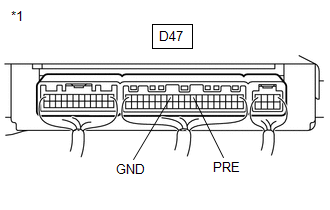
Standard Voltage:
|
Tester Connection |
Condition |
Specified Condition |
|---|---|---|
|
D47-9 (PRE) - D47-13 (GND) |
Refrigerant pressure: Normal pressure (less than 3187 kPa (32.5 kgf/cm2, 462 psi) and more than 390 kPa (4.0 kgf/cm2, 57 psi)) |
1.0 to 4.912 V |
|
*1 |
Component with harness connected (A/C Amplifier) |
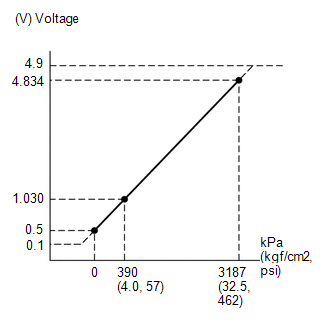
| OK | .gif) |
REPLACE A/C AMPLIFIER |
| NG | .gif) |
GO TO STEP 19 |
|
12. |
REPAIR A/C SYSTEM LEAK |
(a) Identify the area where refrigerant leaks from (See page
.gif) ).
).
(b) Repair the identified area of the A/C system.
(c) Evacuate the A/C system.
| NEXT | .gif) |
CHARGE REFRIGERANT |
|
13. |
INSPECT COOLING FAN SYSTEM |
(a) Check that the cooling fan(s) operates normally.
HINT:
Refer to Cooling Fan Circuit (See page .gif) ).
).
| NG | .gif) |
REPAIR COOLING FAN SYSTEM |
|
|
14. |
CHARGE REFRIGERANT |
(a) Use a refrigerant recovery unit to recover refrigerant.
(b) Evacuate the A/C system.
(c) Add an appropriate amount of refrigerant (See page
.gif) ).
).
HINT:
If refrigerant is added and the system has not been properly evacuated (insufficient vacuum time), moisture in the air remaining in the system will freeze in the expansion valve, blocking the flow on the high pressure side. Therefore, recover the refrigerant and properly evacuate the system. Add an appropriate amount of refrigerant, and check for DTCs.
|
|
15. |
RECHECK DTC |
(a) Recheck for the DTC when the following conditions are satisfied.
|
Item |
Condition |
|---|---|
|
Vehicle Doors |
Fully open |
|
Temperature Setting |
MAX COLD |
|
Blower Speed |
HI |
|
A/C Switch |
on |
|
R/F Switch |
RECIRCULATION |
|
Interior Temperature |
25 to 35°C (77 to 95°F) |
|
Engine Speed |
2000 rpm |
NOTICE:
If refrigerant pressure on the high pressure line is excessive, this DTC will be set. Therefore, it is necessary to measure the voltage over a period of time (approximately 10 minutes) because DTC may be set after the A/C has been operating for a while.
HINT:
- When the outside air temperature is low (below -1.5°C (29.3°F)), the compressor stops due to signals from the ambient temperature sensor and the evaporator temperature sensor to prevent the evaporator from freezing. In this case, perform the inspection in a warm indoor environment.
- If refrigerant is added and the system has not been properly evacuated (insufficient vacuum time), moisture in the air remaining in the system will freeze in the expansion valve, blocking the flow on the high pressure side. Therefore, recover the refrigerant and properly evacuate the system. Add an appropriate amount of refrigerant, and check for the DTC. If the DTC is not output, it indicates that the cooler dryer in the condenser is not able to absorb moisture in the refrigerant. In this case, to complete the repair, it is necessary to replace the cooler dryer.
|
Result |
Proceed to |
|---|---|
|
DTC B1423/23 is output |
A |
|
DTC B1423/23 is not output |
B |
| B | .gif) |
REPLACE COOLER DRYER |
|
|
16. |
REPLACE EXPANSION VALVE |
(a) Replace the expansion valve with a new or a known good one (See page
.gif) ).
).
HINT:
Replace the expansion valve with a new or a known good one because the expansion valve is either stuck or clogged.
|
|
17. |
CHARGE REFRIGERANT |
(a) Add an appropriate amount of refrigerant (See page
.gif) ).
).
|
|
18. |
RECHECK DTC |
(a) Recheck for the DTC when the following conditions are satisfied.
|
Item |
Condition |
|---|---|
|
Vehicle Doors |
Fully open |
|
Temperature Setting |
MAX COLD |
|
Blower Speed |
HI |
|
A/C Switch |
on |
|
R/F Switch |
RECIRCULATION |
|
Interior Temperature |
25 to 35°C (77 to 95°F) |
|
Engine Speed |
2000 rpm |
NOTICE:
If refrigerant pressure on the high pressure line is excessive, this DTC will be set. Therefore, it is necessary to measure the voltage over a period of time (approximately 10 minutes) because this DTC may be set after the A/C has been operating for a while.
HINT:
- When the outside air temperature is low (below -1.5°C (29.3°F)), the compressor stops due to signals from the ambient temperature sensor and the evaporator temperature sensor to prevent the evaporator from freezing. In this case, perform the inspection in a warm indoor environment.
- If refrigerant pressure is not normal after replacing the expansion valve with a new or a known good one, the condenser or pipes may be clogged with dirt, dust or other contaminants. In this case, clean or replace the condenser or pipes.
|
Result |
Proceed to |
|---|---|
|
DTC B1423/23 is not output |
A |
|
DTC B1423/23 is output |
B |
| A | .gif) |
END |
| B | .gif) |
REPLACE CONDENSER |
|
19. |
REPLACE A/C PRESSURE SENSOR |
(a) Replace the A/C pressure sensor (See page
.gif) ).
).
HINT:
Since the A/C pressure sensor cannot be inspected while it is removed from the vehicle, replace the A/C pressure sensor with a new or a known good one and check that the condition returns to normal.
|
|
20. |
RECHECK DTC |
(a) Recheck for the DTC when the following conditions are satisfied.
|
Item |
Condition |
|---|---|
|
Vehicle Doors |
Fully open |
|
Temperature Setting |
MAX COLD |
|
Blower Speed |
HI |
|
A/C Switch |
on |
|
R/F Switch |
RECIRCULATION |
|
Interior Temperature |
25 to 35°C (77 to 95°F) |
|
Engine Speed |
2000 rpm |
NOTICE:
If refrigerant pressure on the high pressure line is excessive, this DTC will be set. Therefore, it is necessary to measure the voltage over a period of time (approximately 10 minutes) because this DTC may be set after the A/C has been operating for a while.
HINT:
When the outside air temperature is low (below -1.5°C (29.3°F)), the compressor stops due to signals from the ambient temperature sensor and the evaporator temperature sensor to prevent the evaporator from freezing. In this case, perform the inspection in a warm indoor environment.
|
Result |
Proceed to |
|---|---|
|
DTC B1423/23 is not output |
A |
|
DTC B1423/23 is output |
B |
| A | .gif) |
END |
| B | .gif) |
REPLACE A/C AMPLIFIER |
 Air Mix Damper Control Servo Motor Circuit (Passenger Side) (B1441/41)
Air Mix Damper Control Servo Motor Circuit (Passenger Side) (B1441/41)
DESCRIPTION
The air mix control servo motor sends pulse signals to indicate the damper position
to the A/C amplifier. The A/C amplifier activates the motor (normal or reverse)
based on these sign ...
 Evaporator Temperature Sensor Circuit (B1413/13)
Evaporator Temperature Sensor Circuit (B1413/13)
DESCRIPTION
The evaporator temperature sensor is installed on the evaporator in the air conditioning
unit to detect the cooled air temperature that has passed through the evaporator
and to contro ...
Other materials about Toyota Venza:
Problem Symptoms Table
PROBLEM SYMPTOMS TABLE
Use the table below to help determine the cause of problem symptoms.
If multiple suspected areas are listed, the potential causes of the symptoms
are listed in order of probability in the "Suspected Area" column ...
Diagnosis System
DIAGNOSIS SYSTEM
1. CHECK DLC3
(a) Check the DLC3 (See page ).
2. FUNCTION OF SRS WARNING LIGHT
(a) Primary check
(1) Turn the ignition switch off. Wait for at least 2 seconds, then turn the
ignition switch to ON. The SRS warning light comes on for app ...
Diagnosis System
DIAGNOSIS SYSTEM
1. DESCRIPTION
(a) When troubleshooting On-Board Diagnostic (OBD II) vehicles, the vehicle must
be connected to the OBD II scan tool (complying with SAE J1987). Various data output
from the vehicle TCM can then be read.
(b) OBD II regul ...
0.1218

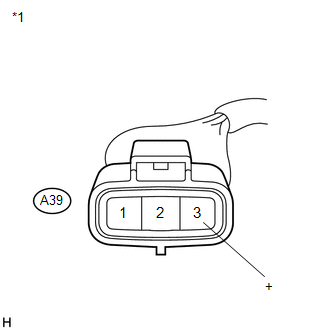
.gif)
